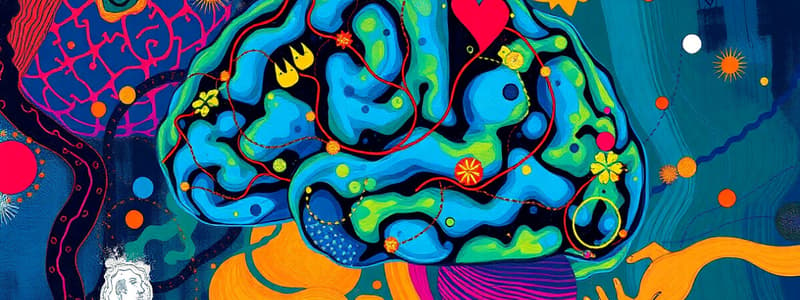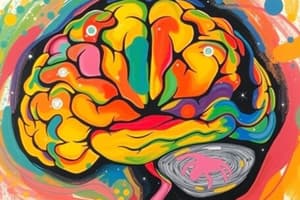Podcast
Questions and Answers
Which of the following describes the primary function of the central nervous system?
Which of the following describes the primary function of the central nervous system?
- To regulate body temperature through sweat glands.
- To filter waste and toxins from the blood.
- To transport nutrients and oxygen to cells throughout the body.
- To coordinate body activities by processing information and sending out instructions. (correct)
The left hemisphere of the cerebrum primarily controls the muscles on the right side of the body.
The left hemisphere of the cerebrum primarily controls the muscles on the right side of the body.
True (A)
What part of the brain controls involuntary activities such as breathing and heart rate?
What part of the brain controls involuntary activities such as breathing and heart rate?
brainstem
The cerebellum is primarily responsible for maintaining ______, posture, and coordination.
The cerebellum is primarily responsible for maintaining ______, posture, and coordination.
Match the brain lobe with its primary function
Match the brain lobe with its primary function
Flashcards
Central Nervous System
Central Nervous System
The control center of the body, comprising the brain and spinal cord.
Spinal Cord
Spinal Cord
A major part of the central nervous system that carries impulses between the brain and the body.
Cerebrum
Cerebrum
The largest part of the brain, responsible for memory, intelligence, and muscle control.
Cerebellum
Cerebellum
Signup and view all the flashcards
Brain Lobes
Brain Lobes
Signup and view all the flashcards
Study Notes
Nervous System
- Central Nervous System (CNS): Composed of the brain and spinal cord. It acts as the body's control center, coordinating bodily activities and receiving and transmitting impulses.
- Peripheral Nervous System (PNS): A network of nerves carrying messages to and from the CNS; enabling rapid bodily responses.
- Brain:
- Cerebrum: Divided into two hemispheres; controlling memory, intelligence, muscle control.
- Cerebellum: Controls balance, posture, and coordination.
- Brainstem: Regulates involuntary functions like breathing and heartbeat.
- Spinal Cord: Crucial for communication between the brain and the rest of the body.
- Nerves: Carry sensory information and motor commands.
- Right Hemisphere Control: Controls the left side of the body.
- Peripheral Nerves: Carry messages to and from the central nervous system.
- Lobes of the Cerebrum:
- Frontal Lobe: Involved in decision-making, problem-solving, and planning.
- Temporal Lobe: Processes sensory information, including hearing, memory, and language.
- Parietal Lobe: Handles sensory information processing, including touch.
- Occipital Lobe: Responsible for processing visual information.
Studying That Suits You
Use AI to generate personalized quizzes and flashcards to suit your learning preferences.
Related Documents
Description
Learn about the central and peripheral nervous systems, including the brain, spinal cord, and nerves. The content covers the cerebrum and the roles of its lobes. Explore how the nervous system enables bodily responses.




